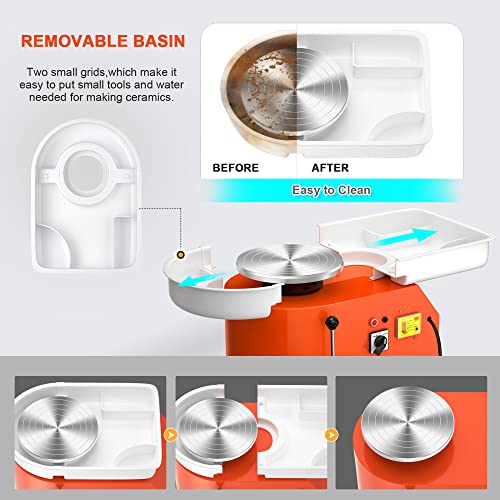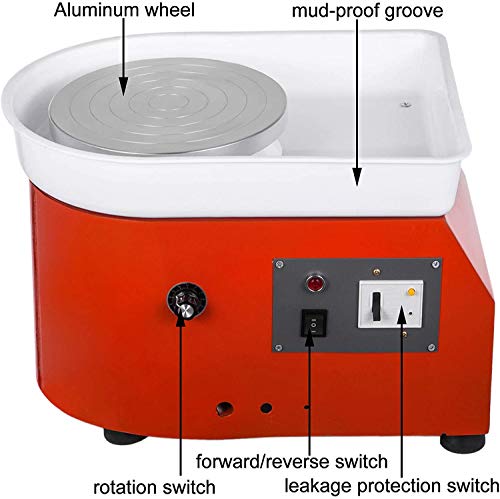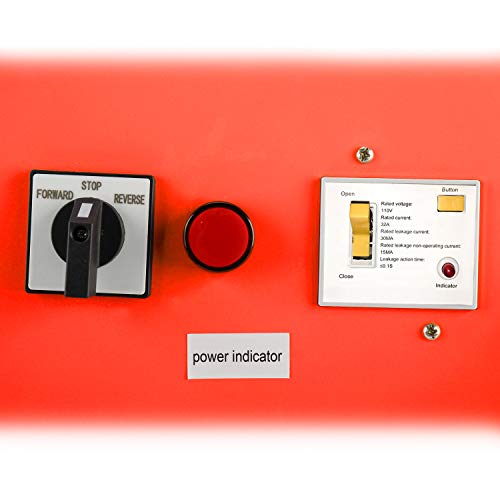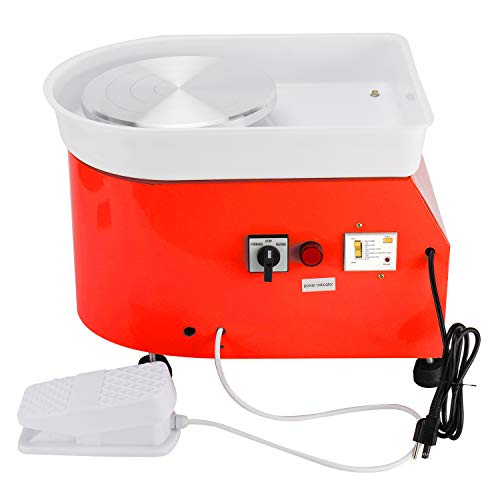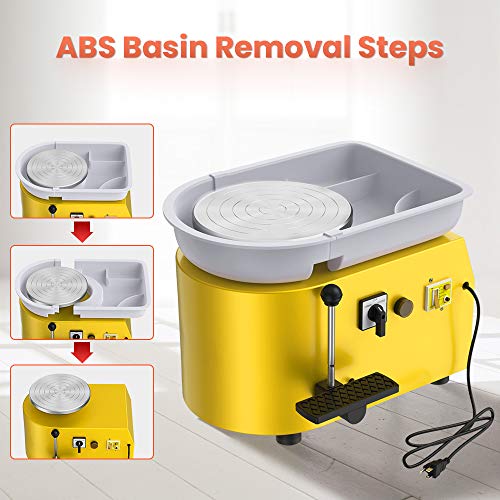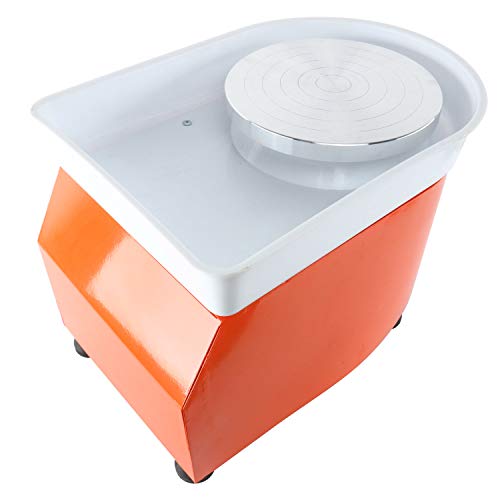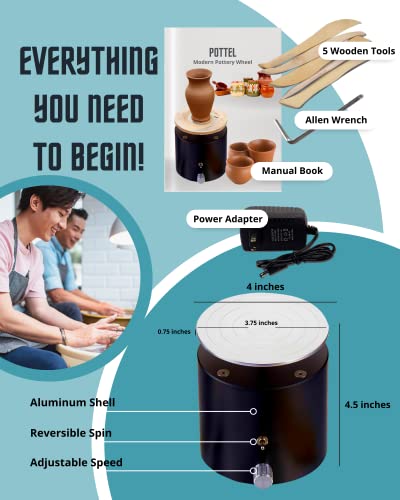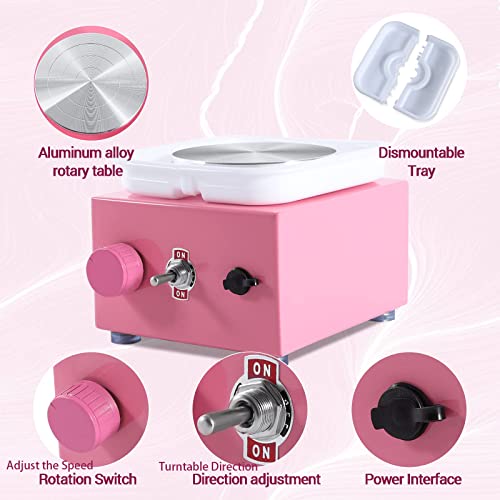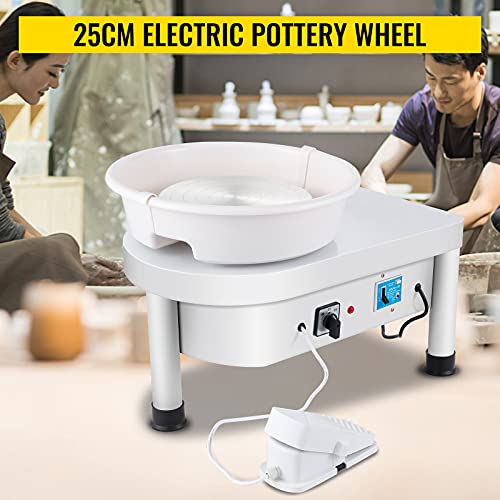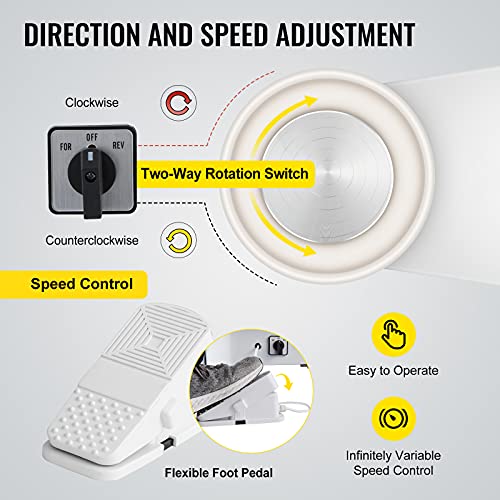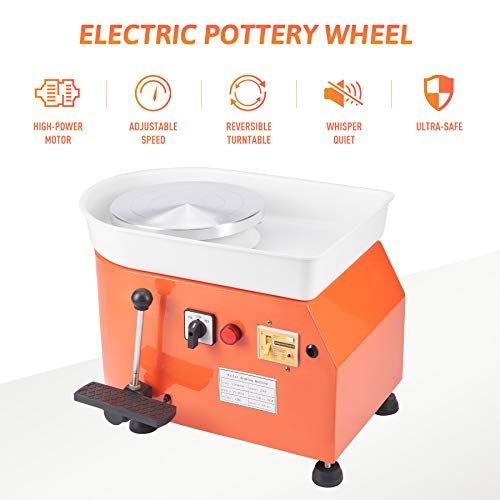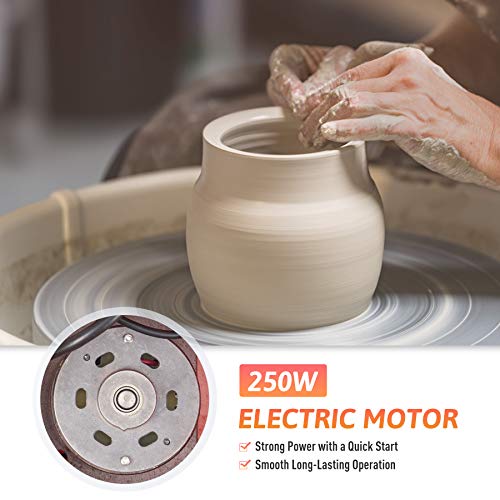pottery wheel
10 Best Pottery Wheels for Beginners Reviewed [Complete Guide]
So you’ve decided to get into the exciting world of pottery making? This ancient craft is as intriguing as magic. There’s nothing quite like the feeling of playing with clay and having beautiful ceramic wares to show for it. The key to getting started on the right foot is to acquire the best pottery wheel for beginners.
The kind of wheel you use can make all the difference between a fantastic and frustrating experience. Having the right beginner pottery wheel can help you learn to throw pottery and refine your sculpting skills in a fun way.
However, choosing your first potter’s wheel can be daunting. To help out, we’ve reviewed the best pottery wheels for beginners and compiled an in-depth buyer’s guide to equip you with the knowledge you need to evaluate the different models.
By the end of this page, you’ll know what to look for in a beginner’s pottery wheel and will be able to pinpoint the perfect clay-forming machine for your needs.
Our Picks for the Best Pottery Wheel for Beginners
| Image | Product | Features | Price |
|---|---|---|---|
Best Overall  |
| Check PriceView Details | |
Best Value  |
| Check PriceView Details | |
Best for Quiet Use:  |
| Check PriceView Details | |
High Clay Load Capacity 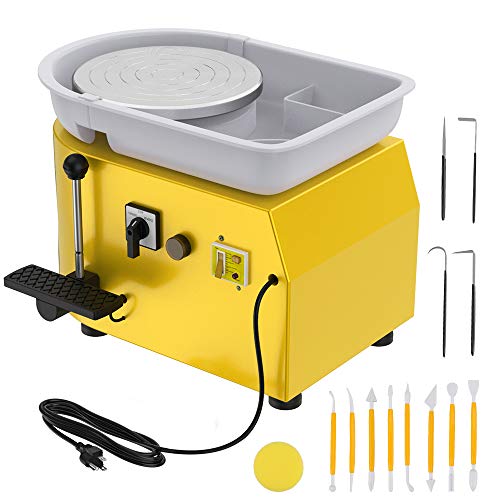 |
| Check PriceView Details | |
Best for Easy Use  |
| Check PriceView Details | |
Best Mini  |
| Check PriceView Details | |
Best Budget  |
| Check PriceView Details | |
Best for Power Saving  |
| Check PriceView Details | |
Best Premium  |
| Check PriceView Details | |
Top Rated  |
| Check PriceView Details |
1. Best Overall: SKYTOU 25cm 350W Electric Pottery Wheel for Beginners
The SKYTOU clay machine is a trendy beginner pottery wheel with hundreds of 5-star reviews.
Pottery learners love that because it's affordable, compact, easy to use, and yet produces high-quality pottery creations even in the hands of a novice. All these reasons make it the best pottery wheel for beginners.
Like most beginner's pottery wheels, it has a 9.8-inch turntable. You can throw and shape small to larger pieces on this surface area. The powerful 350W motor ensures smooth and steady operation even at the fastest rotary speed.
The speed is adjustable via a foot pedal and manual lever, and you can also choose to spin the wheel in any direction. Cleanup is a piece of cake thanks to an enclosed design that keeps out mud and a detachable splash basin.
If you're looking for a quality clay spinning wheel without spending much money, you can't go wrong with the SKYTOU electric beginner pottery wheel kit. Besides the wheel, you get a 14-piece pottery tool set to help you get pottery forming started right away.
Specifications: Item Weight: 28.4 pounds, Dimensions: 5.91 x 3.94 x 1.97 Inches, Plate Size: 9.8 Inches, Rotary Speed: 0-300 RPM, Motor Power: 350W, Rating: 4.3 out of 5.0.
- Top-rated with stellar user reviews
- Great for both throwing and centering
- Produces high-quality pieces
- You can switch the rotation directionAdjustable via handle and foot pedal
- Adjustable via handle and foot pedal
- A removable basin simplifies the cleanup
- Range of vibrant colors to choose from
- Includes a comprehensive clay tool set
- Does not have pins for attaching bats
2. Best Value: VEVOR 25cm 350W Beginner Pottery Wheel for Pottery Forming
The VEVOR beginner pottery wheel boasts a robust build, a powerful motor, and a nicely sized wheel head at an incredibly low price. Add ease of use to the mix, and it easily qualifies as the best pottery wheel for beginners when it comes to value for money.
A 9.8-inch wide wheel head gives you a great surface area to practice throwing and centering pieces. With the 350W motor, the DIY clay tool runs smoothly and can spin up to 300 times per minute. All these specs enable you to produce pro-level pottery, even as a beginner.
As you're throwing, the splash basin contains the clay and water, helping to reduce the mess and simplifying cleanup. Last but not least, the beginner's pottery wheel is compact and easy to store.
Specifications: Item Weight: 33 lbs (15 kg), Dimensions: 22 x 16.1 x 15.7 Inches, Wheel Size: 9.8 Inches, Rotary Speed: 0-300 r/min, Motor Power: 350W, Guarantee: 30-Day Free Return, Rating: 4.3 out of 5.0
- Easy for beginners to use
- Manual speed control
- Forward reverse rotation switch
- Hassle-free cleanup
- Excellent value for money
- Compact footprint
- There is no place to attach bats to the wheel
3. Best for Quiet Use: YaeKoo 25CM 350W Electric Potters Wheel for Beginners with Foot Pedal
Affordable and space efficient, the YaeKoo beginning pottery wheel makes a great starter clay wheel for a beginner on a budget. The wheel plate diameter spans 9.8 inches, giving you enough space to mold small to medium projects such as cups and bowls.
As an electric pottery wheel for beginners, it allows you to focus on throwing and molding the clay with your hands. With the reverse rotation, you can spin it in any direction that feels natural to you.
Furthermore, you can vary the rotating speed via the foot pedal. This allows you to select just the right speed to get the level of control you need as you form your pieces.
Constructed with sprayed metal and aluminum alloy, the affordable wheel is robust but not too heavy. The compact form makes it easy to move around and store when you're not throwing pottery.
Specifications: Item Weight: 27.5 Pounds, Dimensions: 18.3 x 13 x 13 Inches, Wheel Size: 9.84 Inches, Rotary Speed: 0-300 rpm, Motor Power: 250-350W, Noise: <60 dB, Rating: 4.3 out of 5.0.
- Good size for small to medium projects
- Doesn't take up a lot of space
- Easy to use and clean
- Affordable pricing
- Variable speed control
- Forward and reverse rotation
- Low-noise brushless motor
- Comes in vibrant hues
- Sits so low to the ground that you need something to prop it up on
4. Best with High Clay Load Capacity: ANBULL 350W Electric Beginner Pottery Wheel for Pottery Ceramic Clay Work
How about a pottery wheel you can use as a beginner and keep using even when you gain experience and become a pro in pottery sculpting? This is what you get with this Anbull clay molding machine.
It's easy for novice hands to handle yet powerful enough for professional potters. With a 9.8-inch wide pottery head, a high clay loading capacity, and a 350W motor, the pottery wheel for beginners offers plenty of power to mold mugs and bowls.
What we like most about the pottery equipment is that there are two ways to regulate the rotation speed. You can use the foot pedal or the manual lever. Furthermore, you can set the turntable to spin in a clockwise or counter-clockwise direction. Cleanup is hassle-free as you can remove the splash pan.
The beginner's pottery wheel itself is strong and long-lasting. The main body is constructed with electrostatically sprayed metal, while the wheel head is made of rust-resistant aluminum alloy. Overall, Anbull offers a great pottery wheel kit for beginners and superb value for money.
Specifications: Item Weight: 38 Pounds, Load Capacity: 20 KG, Wheel Size: 9.8 Inches, Rotary Speed: 0-300 RPM, Motor Power: 350W, Rating: 4.5 out of 5.0.
- Powerful motor
- Dual speed regulation with food pedal and manual control
- Allows you to reverse the direction of rotation
- Strong and durable construction
- Details instructions provided
- Easy to clean, with a removable splash pan
- Comes with a 13-piece pottery tool set
- Does not have bat pins configured
5. Best for Easy Use: YaeTek 25CM 350W Electric DIY Pottery Wheel for Beginners Adults
If you're serious about pottery and looking for a powerful but affordable and user-friendly beginner pottery wheel for home or school use, the YaeTek pottery forming wheel fits the bill. Featuring a 9.8 inches diameter wheel head, the DIY art craft tool works great for throwing small to larger clay loads.
The 350-watt motor delivers impressive torque, and the machine doesn't get bogged down easily. You can spin in a forward or reverse direction and speed up or slow down the rotation using a foot pedal.
Despite the YaeTek 25CM being a cheap pottery wheel for beginners, the metal and aluminum build is sturdy and bound to last a long time. Though you can't remove the splash basin, the wheel is still fairly easy to clean afterward.
Specifications: Item Weight: 25.3 pounds, Dimensions: 16.54 x 20.47 x 13.78 Inches, Wheel Size: 9.8 Inches, Rotary Speed: 0-300 r/min, Motor Power: 250-350W, Rating: 4.3 out of 5.0.
- Powerful motor
- Decent sized turntable
- Speed adjustable with foot pedal
- You can reverse the direction of rotation
- Sturdy build quality
- Compact design
- Great value for the price
- Sits really low to the ground
6. Best Mini Pottery Wheel: POTTEL Small Potters Wheel Kit for Beginners
The POTTEL beginner pottery wheel is all about simplicity, making it an ideal pottery wheel for first-time users. Setup is a breeze, and the small wheel itself is a joy to use. It's highly rated for how steady, smooth, and quiet it's during operation.
One thing that sets the POTTEL apart from other beginner's pottery wheels is how fast it can spin. It's capable of making a thousand rotations per minute. You can fine-tune the speed to your preference and even reverse the direction in which the wheel spins.
Despite its affordable price, the mini pottery wheel for beginners is very high-quality, with a premium feel. It's made of anodized aluminum, making it rust-, corrosion-, and chip-resistant. The compact design means you don't need much space for pottery practice and storage.
While you'll only be able to throw small loads of clay on the 4-inch turntable, you can't go wrong with the POTTEL as your starter pottery wheel for home use. To top it off, it comes complete with a set of carving tools.
Specifications: Item Weight: 2 Pounds, Item Weight: 2 Pounds, Rotary Speed: 0-1000 spins/minute, Motor Power: 24W, Rating: 4.2 out of 5.0
- Impressive spinning speed
- Simple setup and cleanup
- Smooth and noise-free
- Lightweight and space efficient
- Clear instructions provided
- The rotational speed is adjustable
- Reversible directional switch
- Premium look and feel
- The package includes free tools
- The wheel tends to wobble unless you place it on a hard flat surface
7. Best Budget: Shikha Mini Beginner Pottery Wheel for Kids Home Use
Looking to introduce your child to pottery? Here is the best mini pottery wheel tool kit for teaching kids to this craft. Its low price also makes it a great choice if you'd like to try your hand at pottery but aren't sure whether you will stick with it.
Despite the small size, the Shikha clay spinning wheel has everything you need to practice pottery as a beginner. It even comes with an easy-to-follow manual and a set of free shaping tools.
Its wheel head is only 3.93 inches across, so you will only be able to make tiny ceramic bowls and cups. It can handle up to a 0.5kg clay load. You can adjust the rotation speed as you see fit, and the removable splash pan makes cleanup a breeze.
Last but not least, the compact and lightweight design makes this small beginner pottery wheel easy to store and carry around.
Specifications: Item Weight: 3.52 pounds, Dimensions: 5.9 × 5.2 × 4.4 Inches, Wheel Size: 3.93 Inches, Rotary Speed: 0-300 r/min, Load Capacity: 0.5 KG, Motor Power: 30W, Motor Power: 30W
- Perfect size for kids
- Cheap pottery wheel for beginners
- Very easy to move around
- Capable of super fast spinning
- You can adjust the spin speed
- The detachable basin is easy to clean
- Small footprint
- Attractive finish
- The free tool set is included
- Small pottery wheel kit can only do tiny projects.
8. Best for Power Saving: Mophorn 25cm 250W Electric Pottery Wheel for Beginners Adults
The Mophorn electric potter's wheel offers the best of both worlds. First off, it's equipped with a powerful 250W motor.
Coupled with a user-friendly design, it's one of the best beginner pottery wheels for both home use and pottery classes. From throwing to shaping, it will help you refine your sculpting skills and create beautiful pieces.
The wheel head can support about 3 pounds of clay, which is a good load for a beginner to work. The ability to rotate in either direction and adjust the spinning speed gives you the flexibility to practice different techniques. You can use it comfortably, no matter your hand orientation or directional preference.
Construction quality is top-notch. The machine body is spray painted, while the turntable is rust-resistant aluminum. Although the wheel doesn't come apart for cleanup, the enclosed design does a great job of minimizing the mess.
Specifications: Item Weight: 31.5 Pounds (14.3 KG), Dimensions: 22 x 16.1 x 15.7 Inches, Wheel Size: 9.8 Inches, Rotary Speed: 0-300 r/min, Full Load Power: 250W, No-load Power: 80W,Rating: 4.4 out of 5.0.
- Powerful motor
- Simple to operate
- Good for teaching pottery
- Reverse direction switch
- Variable speed setting
- Mess blocking design
- Compact form factor
- Does not disassemble for cleaning
- Doesn’t have pins for attaching bats
9. Best Premium: VEVOR 280W School and Home Pottery Wheel for Beginners
As a professional-level yet well-priced pottery wheel for beginners, the VEVOR pottery forming machine suits both home use and teaching pottery in a school setting.
It provides a nice 9.8-inch wide plate for molding a range of ceramic projects while honing pottery skills. You can use it for pottery throwing and shaping.
Beginner-friendly features include a variable rotating speed controlled by a foot pedal and two-way rotation. You can use it comfortably, whether left or right-handed, and spin it in any direction you prefer.
An enclosed design and a detachable splash basin make cleanup easy. As for storage, the small footprint doesn't take up too much space.
When you consider the quality level for the price, the VEVOR beginner pottery wheel offers fantastic value for the money. You even get an 8-piece shaping set as a bonus.
Specifications: Item Weight: 32.9 Pounds (14.9 KG), Dimensions: 23.2 x 18.1 x 16.5 Inches, Wheel Size: 9.8 Inches, Rotary Speed: 0-300 r/min, Motor Power: 280W, Rating: 4.0 out of 5.0.
- Has a handle and foot pedal
- Rotates in both directions
- Compact and space efficient
- Comes with shaping tools
- Good for teaching pottery
- Easy-to-clean detachable pan
- Robust build with a machined body
- Great bang for the buck
- Sits really low on the ground
10. Top Rated: CREWORKS 25CM Electric Beginner Pottery Wheel for Pottery Ceramic Forming
This CREWORKS clay wheel comes with the tools you need to get started. Besides the wheel itself, you will get an 8-piece kit for molding and carving.
The physical size makes the beginner pottery wheel ideal for tight spaces, while the wheel diameter suits smaller ceramic pieces. If you're looking for a small clay wheel for kids, this one also fits the bill.
The CREWORKS pottery-making wheel is also easy for beginning potters to use. Powered by a motor and adjustable via a foot pedal, it leaves both hands free. You can also use the side knobs to fine-tune the wheel speed.
Moreover, the pottery wheel for beginners has a reversible turntable that accommodates both right and left-handed users. You can choose to throw and shape pieces to the left or right. As you work, an integrated splash pan catches drip and splatter, making cleanup easy.
Specifications: Item Weight: 26.5 Pounds, Dimensions: 19.7 x 14.2 x 14.2 Inches, Wheel Size: 9.8 Inches, Rotary Speed: 300 RPM, Motor Power: 250W, Rating: 4.6 out of 5.0
- Best pottery wheel for home use
- Great size for adults and kids
- Easy to move around and store
- Lightweight design
- Rotates clockwise and counter-clockwise
- Manual and foot pedal control
- Adjustable speed
- Great value for money
- Includes an 8-piece tool set
- The splash pan isn’t removable
Things to Consider While Buying a Pottery Wheel for Beginners
Now you’ve got a good idea of the best pottery wheels for beginners. As you can see, each model has a myriad of features and specs.
The right pottery wheel for you comes down to several factors, including how big your workstation is and how big the pieces you plan to create are. Here’s an overview of what to look for when buying a beginner’s pottery wheel.
Opt for an Electric Pottery Wheel for Beginners
When starting out throwing pottery, we recommend that you go with an electric pottery wheel. Powered wheels are easy to master and compact enough to move around easily.
Because they are powered by an electric motor, you can focus on throwing and centering the clay. There are two types of electric wheels.
Direct-drive electric pottery wheels are strong, powerful, responsive, and long-lasting. However, they tend to be heavy and bear more expensive price tags.
Belt drive wheels are compact, lightweight, and affordable. On the downside, they are not as powerful as direct drive wheels, and the belt wears out over time and requires replacement.
Manual pottery wheels or kick wheels feature a spinning platform under the seat. You use your feet to kick the platform and operate the wheel. Manual units are more affordable than electric models, but you have to do more work and put in more practice to master their use.
Additionally, you have to work your legs continuously, and repetitive motion can cause knee and arthritis issues. Kick-wheels are also bulky, take up a lot of space, and are cumbersome to move around.
Check the Diameter of the Wheel Head
The spinning part of the pottery wheel that shapes the clay is referred to as the wheel head.
Consider how big this circular head is, as it affects the size of items you can create. The larger the turntable, the more clay it can handle and the larger the projects you can mold on it.
Will you be making broad projects such as plates and pots? You’ll need a large surface area for all the clay you’ll be molding. For small projects such as cups and bowls, a smaller wheel head will suffice. The standard size for most beginner wheel head diameters is about 10 inches.
Check the Motor Power
Different pottery wheels have different motor powers. The higher the motor power, the heavier the clay load it can support and the larger the projects you can craft. A powerful motor also enables the wheel head to spin smoothly.
Most beginner pottery wheels have motors with a 250 to 350 watts power rating. The higher the power, the more clay the wheel can handle and the smoother it operates.
Find Out the Spinning Speed
The speed at which the wheel head turns is also crucial. It affects the amount of torque the motor delivers and determines how much control you have over the wheel.
Most beginner pottery wheel motors can handle up to 300 revolutions per minute (RPMs).
A slower rotating speed gives you more control as a novice. Fortunately, most pottery wheels have variable speed settings. You can adjust the speed of the wheel as you throw.
It’s also a good idea to double-check how the speed is controlled. You can adjust the speed to your liking.
Look for a Rotation Direction Reverse Switch
Whether you’re right-handed or left-handed, look for a beginner pottery wheel with a reversible switch. It allows you to change the direction the wheel rotates.
Right-handed potters usually turn the wheel in an anti-clockwise direction, while left-handed users throw in a clockwise direction.
Still, you might find that you prefer to throw pottery in a clockwise or anti-clockwise direction. Moreover, reversing the spinning direction can help you create interesting patterns on your items.
Pay Attention to the Size and Weight
Beginner pottery wheels for home use come in various sizes and weights. It’s important to pay attention to these specs. You don’t want to end up with a machine that’s too big for the space you’ve allocated for it.
Do you live in a small apartment with limited space? Will you be moving your pottery around? Opt for a compact, lightweight tabletop wheel that’s easy to move around.
If you’re on a tight budget or looking for a beginner pottery wheel for kids, consider mini pottery wheels designed to create tiny mugs and bowls.
Do you have a dedicated space for your wheel? Then you can get a larger wheel as you don’t have to worry about storage and transportation.
A Beginner Pottery Wheel Should Be Easy To Use
A good pottery wheel for beginners should make it easy to adjust the spinning speed while also using your hand to control the wheel. There are two ways to control the speed.
Lever-based wheels have a manual handle that you turn to control the speed. With pottery wheels controlled by a foot pedal, you adjust the wheel speed with your feet.
Pottery throwing gets messy, so it’s a good idea to go for one with a detachable splash basin. This pan catches the clay that flies off as the wheel spins, making cleanup easier.
Assess the Build Quality
A pottery wheel should withstand exposure to water without rusting or corroding. Look for a wheel body made of spray-treated metal. The wheel head should be made of rust- and corrosion-resistant aluminum alloy.
An enclosed design prevents the clay and water from getting into the fuselage. For safety reasons, when using an electric pottery wheel, look for a single-phase three-wire connection with earth leakage protection.
Cost of a Beginner Pottery Wheel
Your pottery wheel will become an integral part of your work. There are differences in wheels, so you need to determine your needs and then look for the best-priced wheels that suit them best. Pottery wheels are a significant expense; be sure to compare stores.
Check with several online suppliers and local ceramic and artist suppliers. Don’t forget to compare the shipping cost with the cost of the pottery wheel itself. It is expected that a new pottery wheel will cost hundreds to thousands of dollars. I strongly recommend that you take a course to discover whether your interest level is high enough to justify purchasing your first pottery wheel.
Longevity
If you purchase your pottery wheel, it seems appropriate to get a “beginner” wheel. However, if you want pottery to be a fundamental part of your life, you may want to spend more money on wheels.
The reason is that your wheels will last a long time. With proper maintenance, electric wheels can be used for ten years or more. Not only should you consider your current needs but also your long-term goals in pottery. It would help if you had a pottery wheel to continuously meet your needs as you grow and develop as a potter.
Portability
When choosing between electric wheels and kick wheels, portability is the primary consideration. Electric wheels are almost always easier to carry than handwheels. They are smaller and lighter. If you foresee moving your studio later in the future and want to carry it with you, for example, at an art festival, not only portability plays a role.
Tips on Maintaining a Pottery Wheel for Beginners
Once you find the best pottery wheel for home use, it’s important to take good care of it. Follow these care and maintenance tips to keep your clay machine in good condition and ensure it serves you for a long time.
- Read and adhere to the instructions outlined in the provided user manual.
- Always unplug your electric pottery wheel after use. Leaving it plugged in can cause damage due to overheating.
- Clean your pottery wheel as soon as you’re done practicing pottery. Remove the splash pan, empty the splatter, and clean the pan. Next, use a damp sponge to wipe the wheel body and other components.
- Ensure the foot pedal is completely dry to keep rust at bay.
- Store the pottery wheel in a safe place and away from the elements.
FAQs About Pottery Wheels for Beginners
1. What is the Best Beginner Pottery Wheel?
A good pottery wheel for beginners should be high-quality, reliable, affordable, and easy to use. All the above pottery wheels meet these criteria.
Our top pick for the best beginner pottery wheel is the best overall SKYTOU pottery wheel for beginners, which has a large turntable, and a powerful motor and yet is easy for novice pottery to use and offered at a great price that won’t break the bank.
2. What are the Different Types of Pottery Wheels?
Based on design and size, there are two types of pottery wheels: tabletop and freestanding pottery wheels. Tabletop wheels are compact and designed to be set up on a table or any other hard flat surface. Freestanding wheels have legs and are mounted on the floor.
Based on the mode of operation, there are electric and manual pottery wheels. Electric pottery wheels are powered by electricity, while manual or kick wheels are driven by the potter’s legs.
3. Is It Worth Buying a Pottery Wheel?
A pottery wheel is a worthy investment whether you’re planning to pursue pottery as a hobby, business, or profession. The benefits you will reap include relaxation and beautiful pottery pieces made with your own hands.
While you can get a cheap beginner pottery wheel, it’s worth it to spend more money on a quality wheel. It will allow you to make quality porcelain wares and will last a long time.
4. Is It Hard To Use a Pottery Wheel as Beginner?
As with any other skill, there’s a bit of a learning curve to conquer at the beginning. Most pottery wheel beginners find centering the clay to be the biggest challenge.
Using a pottery wheel requires a delicate touch and patience. It can take several tries to get the hang of throwing pottery. It gets easier with practice and soon becomes second nature.
5. What is the Average Cost of a Pottery Wheel for Beginners?
Pottery wheel prices vary widely. They range from around $50 for mini pottery wheels to $400 to $1500 for high-end models aimed at pro-level potters. The average cost for beginner pottery wheels is $200.
6. Can You Do Pottery At Home Without A Kiln?
You can practice pottery without a kiln. A basic pottery wheel and a lump of clay are all you need to throw pottery at home and do great projects.
7. What Kind of Clay is Used for Pottery Wheels?
Potter’s clay is the best type of clay to use with pottery wheels. Furthermore, stoneware clay is the best option for creating dishwasher-safe pieces because it’s subjected to very high temperatures.
8. How Long Does A Beginner Pottery Wheel Last?
With proper care and maintenance, a beginner potter’s wheel can last ten years or more. These machines are made of corrosion- and rust-resistant materials that stand the test of time.
Conclusion
Choosing the right pottery wheel for beginners is very important when getting into pottery. After all, it’s the most basic piece of equipment in pottery throwing.
We hope this beginner pottery wheel buying guide has equipped you with knowledge on picking the right pottery wheel, and you can now make an informed decision on the best pottery wheel for beginners to suit your needs.



